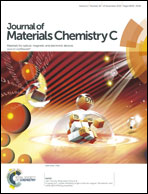One step fabrication of glass–silver@core–shell fibers: silver-doped phosphate glasses as precursors of SERS substrates
Abstract
In this study we report on the fabrication, morphological characterization, and surface enhanced Raman scattering (SERS) activity of innovative glass–silver@core–shell substrates obtained by an inexpensive and simple approach. Silver-doped glass fibers were obtained from the phosphate glass system NaH2PO4–GeO2–Al2O3 (3% AgNO3) using the conventional melt quenching technique. The subsequent thermal treatment of the silver-doped glass fibers, in the range of 150 to 350 °C, for annealing times up to 30 min under reducing hydrogen atmosphere, induces migration of the as-dispersed silver ions toward the surface, where they are reduced to form silver-based shell nanostructures on the glass core. We found the SERS activity of the as-produced glass–silver@core–shell fibers can be easily controlled by setting both the annealing temperature and time. Field-emission scanning electron microscopy (FE-SEM) was used to characterize the morphology of the as-produced SERS active substrates, which were correlated with the SERS signal using cresyl violet (CV) as the model. The as-produced glass substrates decorated with silver-based nanostructures revealed to be a robust candidate and a very efficient SERS substrate, providing Raman signal enhancement of about 105 fold orders of magnitude while compared with the silver-undoped glass substrate. Finally, based on the morphological and optical data we proposed a one-step mechanism for the growth of the silver-based nanostructures under the employed synthesis condition.



 Please wait while we load your content...
Please wait while we load your content...